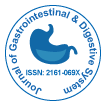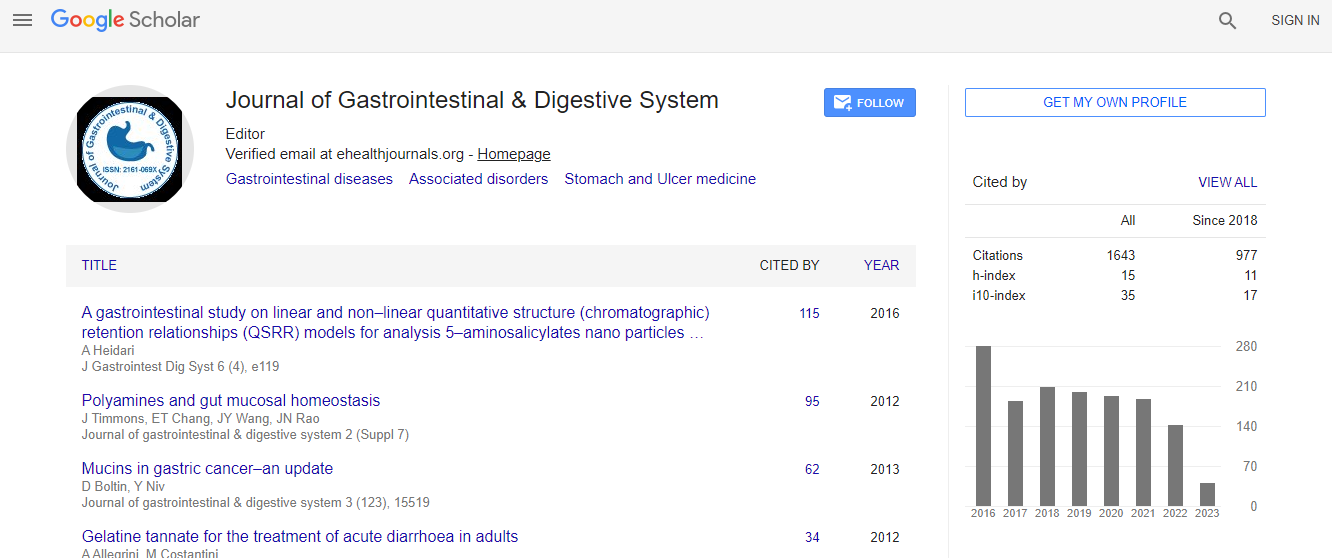Our Group organises 3000+ Global Conferenceseries Events every year across USA, Europe & Asia with support from 1000 more scientific Societies and Publishes 700+ Open Access Journals which contains over 50000 eminent personalities, reputed scientists as editorial board members.
Open Access Journals gaining more Readers and Citations
700 Journals and 15,000,000 Readers Each Journal is getting 25,000+ Readers
Google Scholar citation report
Citations : 2091
Journal of Gastrointestinal & Digestive System received 2091 citations as per Google Scholar report
Journal of Gastrointestinal & Digestive System peer review process verified at publons
Indexed In
- Index Copernicus
- Google Scholar
- Sherpa Romeo
- Open J Gate
- Genamics JournalSeek
- China National Knowledge Infrastructure (CNKI)
- Electronic Journals Library
- RefSeek
- Hamdard University
- EBSCO A-Z
- OCLC- WorldCat
- SWB online catalog
- Virtual Library of Biology (vifabio)
- Publons
- Geneva Foundation for Medical Education and Research
- Euro Pub
- ICMJE
Useful Links
Recommended Journals
Related Subjects
Share This Page
What is the role of ERCP in the diagnosis of hemosuccus pancreaticus?
18th Euro-Global Gastroenterology Conference
Kwak Yun Mi*, Paik Kyu-hyun, Kim Ji Chang and Park Won SuK
Catholic University of Korea, South Korea
ScientificTracks Abstracts: J Gastrointest Dig Syst
Abstract
Hemosuccus Pancreaticus (HP) is one of the rare causes of gastrointestinal bleeding, sometimes leading to a life-threatening condition. However, the diagnosis of HP is often delayed as its rarity and intermittent signs of bleeding, which still is challenging to determine the bleeding source for some patients. An 83-year-old man was transferred to our hospital to evaluate the source of intermittent upper gastrointestinal bleeding involving melena and worsening anemia. Initial upper and lower gastrointestinal endoscopies could not reveal any source of bleeding. Emergent upper endoscopy performed with hematochezia and hypotension confirmed a spurt of bleeding from the major duodenal papilla However, contrast-enhanced CT and angiography could not find the source of the bleeding from the major duodenal papilla. Here, Endoscopic Retrograde Cholangio Pancreatography (ERCP) for inducing the bleeding from the source and indicating the bleeding point was performed according to the decision of the multidisciplinary team Immediately thereafter, sequential angiography was performed, and HP due to the rupture of a pseudoaneurysm of the splenic artery could be diagnosed. As a result, it was possible to avoid surgical resection of the pancreas by accurately embolizing the bleeding focus of HP under a multidisciplinary team approach. The patient was discharged in a hemodynamically stable condition. There was no further gastrointestinal bleeding or procedure-related complications till 6 months of discharge.Biography
Kwak Yun Mi graduated medical school and trained about internal medicine until now, she is training fellowship of catholic hospital of Republic of Korea. She has interest in gastroenterology part of internal medicine and she hope that she will be a professional doctor of internal medicine of gastroenterology.

 Spanish
Spanish  Chinese
Chinese  Russian
Russian  German
German  French
French  Japanese
Japanese  Portuguese
Portuguese  Hindi
Hindi 
